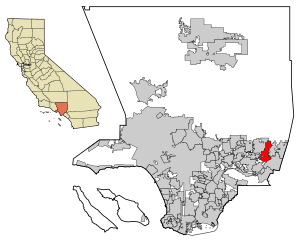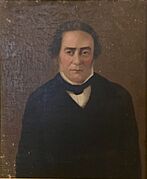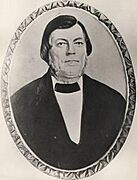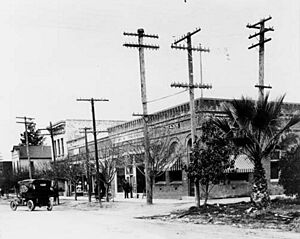San Dimas, California facts for kids
Quick facts for kids
San Dimas, California
|
||
|---|---|---|

City Hall (2017)
|
||
|
||

Location within California and Los Angeles County
|
||
| Country | ||
| State | ||
| County | Los Angeles | |
| Incorporated | August 4, 1960 | |
| Named for | St. Dismas | |
| Government | ||
| • Type | City council/city manager | |
| Area | ||
| • Total | 15.42 sq mi (39.94 km2) | |
| • Land | 15.03 sq mi (38.93 km2) | |
| • Water | 0.39 sq mi (1.01 km2) 2.53% | |
| Elevation | 955 ft (291 m) | |
| Population
(2020)
|
||
| • Total | 34,924 | |
| • Estimate
(2024)
|
33,226 | |
| • Density | 2,323.3/sq mi (897.0/km2) | |
| Time zone | UTC-8 (PST) | |
| • Summer (DST) | UTC-7 (PDT) | |
| ZIP code |
91773
|
|
| Area code | 909 | |
| FIPS code | 06-66070 | |
| GNIS feature IDs | 1652785, 2411784 | |
San Dimas is a city in the San Gabriel Valley of Los Angeles County, California, United States. Its name comes from a Spanish word meaning "Saint Dismas". In 2020, about 34,924 people lived there. The city got its name from San Dimas Canyon, which is in the San Gabriel Mountains nearby.
San Dimas is surrounded by mountains and other cities. To the north are the San Gabriel Mountains. Glendora and Covina are to the west. La Verne is to the north and east. Pomona is to the south and east. Walnut and the area of Ramona are to the southwest. There's also a small area called West San Dimas inside the city.
Contents
History of San Dimas
Early Beginnings
Long ago, Tongva Native Americans lived in the area that is now San Dimas. The first Europeans arrived in 1774. This was during an expedition led by Juan Bautista de Anza.
In 1837, the land became part of a large Mexican land grant. Governor Juan Bautista Alvarado gave the land to Ygnacio Palomares and Ricardo Vejar. This area was called Rancho San Jose. It was also known as La Cienega Mud Springs. This name came from the muddy springs and marshy areas. Palomares and Vejar raised sheep and cattle there. They also grew crops for their families.
Growth and New Name
In the early 1860s, a big drought caused many animals to die. Ygnacio Palomares passed away in 1864. His family started selling parts of the ranch. Ricardo Vejar also lost his share of the land. In 1866, a man named Louis Phillips bought the ranch.
In 1887, the Los Angeles and San Gabriel Valley Railroad arrived. This led to the area being mapped for the first time. A company called San Jose Ranch Company planned out streets. Small businesses started to open. The town then got its new name: San Dimas.
Farming and Citrus Groves
San Dimas grew quickly and became a farming town. Farmers first planted crops like wheat. Later, orange and lemon groves covered the town. At one point, San Dimas had four places to pack citrus fruits. It also had a factory that made marmalade. The famous Sunkist name actually started here. Oranges were the main crop and business until the mid-1900s.
Modern San Dimas
San Dimas officially became a city in 1960. Today, it is known for its Western art and small-town feel. It is also known for its horse-riding activities. In the 1990s, San Dimas hosted the Miss Rodeo California State Pageant. This event was part of the city's Western Days and Rodeo.
In 1971, the city bought the San Dimas Golf Course. The San Dimas Community Hospital opened in 1972. In 1981, the San Dimas Swim and Racquet Club was built.
Geography of San Dimas
San Dimas is a suburb of Los Angeles County. It is located near the foothills of the San Gabriel Mountains. The city is about 28 miles (45 km) east of downtown Los Angeles. It is also north of the Pacific Ocean.
The city covers about 15.4 square miles (39.9 km2). About 0.39 square miles (1.01 km2) of this area is water. Cinnamon Creek flows through the city. It runs near Arrow Highway and goes to Cinnamon Falls.
Transportation in San Dimas
San Dimas is located along historic U.S. Route 66. Other important roads include Arrow Highway and San Dimas Avenue. The Foothill Freeway (I-210) connects the city to Pasadena. California State Route 57 connects to Orange County and the beaches.
The Los Angeles Metro Rail A Line train is being extended to Pomona. This extension includes a San Dimas station. The station is currently being built. It is expected to open in early 2025.
Climate in San Dimas
San Dimas has hot and dry summers. The average monthly temperature is not above 71.6°F (22°C). This type of weather is called a warm-summer Mediterranean climate.
People of San Dimas
Population Changes Over Time
| Historical population | |||
|---|---|---|---|
| Census | Pop. | %± | |
| 1970 | 15,692 | — | |
| 1980 | 24,014 | 53.0% | |
| 1990 | 32,397 | 34.9% | |
| 2000 | 34,980 | 8.0% | |
| 2010 | 33,371 | −4.6% | |
| 2020 | 34,924 | 4.7% | |
| 2024 (est.) | 33,226 | −0.4% | |
| U.S. Decennial Census 1860–1870 1880–1890 1900 1910 1920 1930 1940 1950 1960 1970 1980 1990 2000 2010 2020 |
|||
San Dimas first appeared as a city in the 1970 U.S. Census.
San Dimas Today (2020 Census)
| Race / Ethnicity (NH = Non-Hispanic) | Pop 2000 | Pop 2010 | Pop 2020 | % 2000 | % 2010 | % 2020 |
|---|---|---|---|---|---|---|
| White alone (NH) | 21,381 | 17,448 | 14,275 | 61.12% | 52.28% | 40.87% |
| Black or African American alone (NH) | 1,114 | 1,015 | 1,200 | 3.18% | 3.04% | 3.44% |
| Native American or Alaska Native alone (NH) | 117 | 77 | 89 | 0.33% | 0.23% | 0.25% |
| Asian alone (NH) | 3,216 | 3,381 | 4,868 | 9.19% | 10.13% | 13.94% |
| Native Hawaiian or Pacific Islander alone (NH) | 63 | 36 | 26 | 0.18% | 0.11% | 0.07% |
| Other race alone (NH) | 53 | 61 | 196 | 0.15% | 0.18% | 0.56% |
| Mixed race or Multiracial (NH) | 873 | 862 | 1,325 | 2.50% | 2.58% | 3.79% |
| Hispanic or Latino (any race) | 8,163 | 10,491 | 12,945 | 23.34% | 31.44% | 37.07% |
| Total | 34,980 | 33,371 | 34,924 | 100.00% | 100.00% | 100.00% |
The 2020 United States census showed that San Dimas had 34,924 people. There were 11,396 households. The population density was about 2,322 people per square mile (897 per km2).
The city's population was 49.5% White, 3.8% Black or African American, and 14.3% Asian. About 37.0% of the people were Hispanic or Latino.
About 20.4% of households had children under 18. The average household had 2.9 people. The average family had 3.36 people. The median age in the city was 42 years. About 53.5% of the population was female.
The median income for a household was $90,234. For families, it was $110,969. About 8.8% of the people lived below the poverty line.
Most people (58.1%) in San Dimas were employed. The average commute to work was 33.3 minutes. Most people (74.9%) drove alone to work.
Things to Do in San Dimas
Fun Places to Visit
- Raging Waters Los Angeles: This is one of California's biggest water parks.
- The Pacific Railroad Museum: You can find this museum and library in the old ATSF San Dimas Depot. It is run by the Pacific Railroad Society.
- Frank G. Bonelli Regional Park: A large park with many outdoor activities.
- San Dimas Dog Park: A place for dogs to play.
- San Dimas Canyon Natural Area and Nature Center: This was the first nature center in Los Angeles County. It opened in the 1950s. You can learn about local animals and the area's history here.
Local Businesses
- Headquarters of Magellan Navigation: This company was a leader in global positioning system (GPS) technology.
- Headquarters of Curative: This healthcare company became well-known for its COVID-19 testing and COVID-19 vaccinations.
City Government
In the California State Legislature, San Dimas is part of the 25th Senate District and the 41st Assembly District.
For the United States House of Representatives, San Dimas is in the 31st Congressional District.
Education in San Dimas
Most students in San Dimas attend schools in the Bonita Unified School District. Many go to San Dimas High School. Some students in the Via Verde neighborhood attend South Hills High School. A few students go to schools in the Charter Oak Unified School District.
The city is also home to Life Pacific College. This college is connected to the International Church of the Foursquare Gospel. It offers different college degrees.
City Services
Law Enforcement
The Los Angeles County Sheriff's Department provides police services for San Dimas. They operate the San Dimas Station.
Fire Department
The Los Angeles County Fire Department protects the city from fires.
Health Care
The Los Angeles County Department of Health Services runs the Pomona Health Center. This center serves most of San Dimas. Some parts of the city are served by the Monrovia Health Center.
Famous People from San Dimas
Many notable people have lived in or have a connection to San Dimas.
- Ewell Blackwell: A baseball player for the Cincinnati Reds.
- Shannan Click: A fashion model.
- Jamie Dantzscher: A gymnast who competed in the 2000 Olympics.
- Bill Dwyre: A columnist for the Los Angeles Times.
- D.J. Hackett: A wide receiver in football.
- Ashley Hatch: A soccer player for the U.S. national team.
- Christian Jimenez: A soccer player for Real Salt Lake.
- Ian Johnson: A football player for the Detroit Lions.
- Derek Klena: An actor known for musicals like Anastasia.
- Peter Lambert: A baseball player for the Colorado Rockies.
- Lela Lee: An actress and comic book writer.
- Alex Morgan: A soccer player for the U.S. national team.
- Wayne Moses: A football coach for many teams, including USC and UCLA.
- Bre Payton: A writer for The Federalist.
- Chris Pettit: A baseball player for the Los Angeles Angels of Anaheim.
- P. J. Pilittere: A Major League Baseball coach.
- Brett Pill: A Major League Baseball player.
- Jeremy Reed: A baseball player for the New York Mets.
- Esther Snyder: Co-founder of In-N-Out Burger.
- Guy Snyder: Former president of In-N-Out Burger.
- Harry Snyder: Co-founder of In-N-Out Burger.
- Lynsi Snyder: The current owner of In-N-Out Burger.
- Rich Snyder: Former president of In-N-Out Burger.
- J. J. Spaun: A professional golfer.
- Horace Jeremiah "Jerry" Voorhis: A U.S. Representative and founder of a school for boys.
- Adam Wylie: An actor known for the TV series Picket Fences.
See also
 In Spanish: San Dimas (California) para niños
In Spanish: San Dimas (California) para niños





